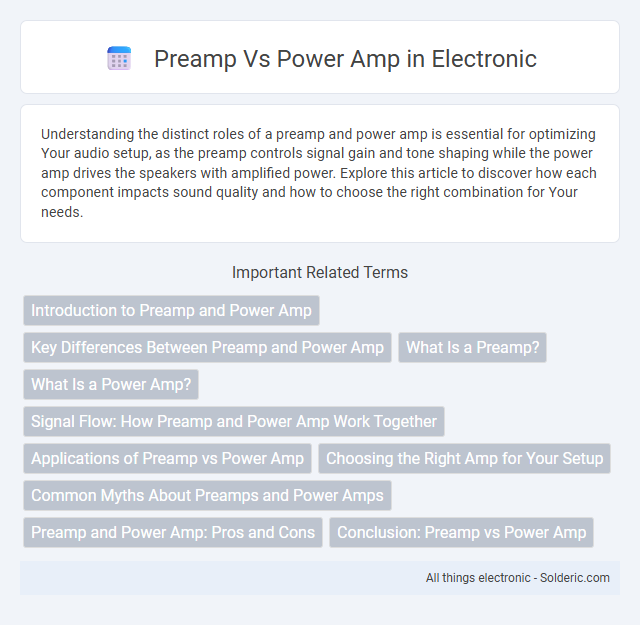Understanding the distinct roles of a preamp and power amp is essential for optimizing Your audio setup, as the preamp controls signal gain and tone shaping while the power amp drives the speakers with amplified power. Explore this article to discover how each component impacts sound quality and how to choose the right combination for Your needs.
Comparison Table
| Feature | Preamp | Power Amp |
|---|---|---|
| Primary Function | Signal boost and tone shaping | Amplifies signal to drive speakers |
| Signal Level | Low-level (mic or instrument level) | High-level (speaker level) |
| Controls | Gain, EQ, tone controls | Volume, impedance matching |
| Output | Line-level signal | Speaker-level signal |
| Placement in Signal Chain | First stage (before power amp) | After preamp, before speakers |
| Distortion Role | Adds tonal coloration/distortion | Primarily clean power amplification |
| Examples | Tube preamps, solid-state preamps | Tube power amps, solid-state power amps |
Introduction to Preamp and Power Amp
A preamp boosts weak audio signals from sources like microphones or guitars to line level, shaping tone and adding gain before sending it to the power amp. The power amp then amplifies this line-level signal to drive speakers, delivering the volume and power needed for live sound or recordings. Understanding the roles of your preamp and power amp ensures proper signal processing and optimal audio performance.
Key Differences Between Preamp and Power Amp
Preamp processes low-level audio signals and controls volume, tone, and source selection, serving as the initial stage in an audio system. Power amp amplifies the preamplified signal to a level sufficient to drive speakers, delivering the necessary wattage for sound output. Key differences include their role in the signal chain, signal voltage levels handled, and functionality in shaping versus amplifying audio signals.
What Is a Preamp?
A preamp, or preamplifier, is an essential audio device that amplifies low-level audio signals to line level for further processing. It boosts weak signals from microphones or instruments, ensuring clear sound before the power amp amplifies it to drive speakers. Your audio system relies on the quality of the preamp to maintain signal integrity and reduce noise.
What Is a Power Amp?
A power amp is an electronic device designed to amplify low-level audio signals from the preamp to a level sufficient to drive speakers and produce sound. It focuses solely on increasing signal strength without altering tone or audio characteristics, making it essential for delivering the necessary wattage and power to your audio system. In contrast to preamps, power amps handle the final stage of amplification, ensuring your speakers receive clean, robust signals for optimal performance.
Signal Flow: How Preamp and Power Amp Work Together
The preamp shapes and boosts the initial audio signal, preparing it for amplification, while the power amp receives this processed signal to drive the speakers with sufficient power. Signal flow begins as your instrument or microphone sends sound to the preamp, which fine-tunes tone, gain, and volume before forwarding the signal to the power amp. This seamless collaboration ensures your audio maintains clarity and strength from input to output.
Applications of Preamp vs Power Amp
Preamp applications include boosting weak audio signals from microphones or instruments to line level, shaping tone and adding effects before sending the signal to the power amp. Power amp applications focus on amplifying the line-level signal from the preamp to drive loudspeakers with sufficient power and clarity for live sound reinforcement or home audio systems. Your audio setup relies on the preamp for precise signal control while the power amp provides the necessary output strength to deliver quality sound to your speakers.
Choosing the Right Amp for Your Setup
Selecting the right amp for your setup depends on your audio needs and equipment compatibility; preamps are essential for boosting low-level signals and shaping tone, while power amps provide the necessary wattage to drive speakers effectively. If your system involves multiple signal sources or requires precise tonal control, integrating a dedicated preamp enhances sound quality and flexibility. For straightforward setups prioritizing loudness and power delivery, a power amp alone may suffice, but combining both amplifiers yields optimal performance and versatility.
Common Myths About Preamps and Power Amps
Common myths about preamps and power amps often confuse their distinct functions, with many believing preamps solely control volume rather than shaping tone and adding gain. Another misconception is that power amps do not influence sound quality, but high-quality power amps can significantly impact dynamics and clarity. Understanding the true roles helps avoid misusing gear and optimizes audio system performance.
Preamp and Power Amp: Pros and Cons
A preamp boosts weak audio signals and shapes the tone, offering precise control and versatility, but can introduce noise if poorly designed. Power amps amplify the preamp's signal to drive speakers with high power and efficiency, essential for volume and clarity, although they may lack tone-shaping capabilities. Understanding the pros and cons of your preamp and power amp helps optimize your audio setup for the best sound quality and performance.
Conclusion: Preamp vs Power Amp
Preamp and power amp serve distinct roles in audio amplification: the preamp shapes and boosts low-level audio signals, while the power amp drives speakers by providing the necessary voltage and current. Choosing between preamp and power amp depends on your audio setup needs, with preamps offering tonal control and power amps delivering raw amplification. For optimal sound performance, integrating both components ensures signal clarity and sufficient power output.
Preamp vs Power amp Infographic

 solderic.com
solderic.com